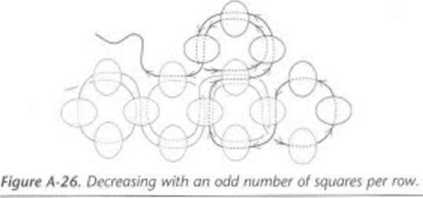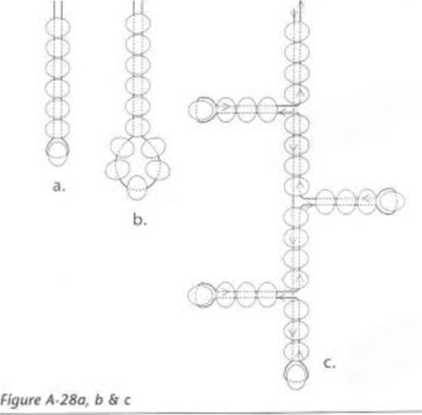51

Bf ADI.D AMULET PURSES • APPENDIX A SI
Single-needle,
Right-angle Weave
Decreasing at the sides
Used in Project Six
Decreasing at the sides of the single-needle, right-angle weave is very simple. Be surę you have completed the row and then position the thread to begin one square from the edge.
If the row has an odd number of squares. Add the two
beads of the last square, then take the needle down through the left vertical bead of the previous square, through the lower horizontal of the second from the last square of the row, up through the left verlical bead of the same square, and finally through the upf>er horizontal of that same inside square (figurę A-26). You have just gone through all four beads of the second square from the edge. String on three beads and continue as usual.

If the row has an even number of squares. When com-pleting the last square of the row, do not pass through the upper horizontal bead as usual. Exit the left vertical bead and then pass through the upper horizontal bead of the previous square of the row (figurę A-27). String on three beads and continue as usual.

Figurę A-27. Decreasing with an even number of sguores per row.
Fringe
Fringe adds movement to the woven beadwork. It can ałso obscure a seam. Fringe is an excellent design element in which to use larger beads that are difficult to mcorporate within the woven bead fabric.
To make a single standard fringe element. String several beads. Take the needle back through all but the last bead strung. In other works, the thread goes through the bottom bead only once but twice through all the other beads of the fringe (figurę A-28a). Figurę A-28b is a vari-ation of this fringe.
Branched Fringe
The branched fringe, or kinky fringe, has become very popular in the last few years and can be surprisingly ver-satile. In Projects Three and Four, the artists used dense-ly packed, longer branched fringes to lend textural and visual interest. In Project Six, David Chatt used two larger beads to make shori branches to create a very textur-al, frilled edge around the woven bead fabric.
To make a sample of branched fringe. String sixteen seecf beads and take the needle back through the first three of the last four beads. Bring the needle out between the fourth and fifth bead from the bottom. String on four beads and take the needle back through three beads — a branch. Continue up the strand passing through four morę beads. Make anothcr branch and continue up four beads, make another branch. Exit out the last four beads of the main column (figurę A-28c).

Wyszukiwarka
Podobne podstrony:
BEADED AMULET PURSES • APPENDIX Et SSTo begin single-needle, right-angle weave Tie the base strand i
BŁADEO AMULET PURSES • APPENDIX A 49 Figurę A■ 17. Starting a nev/ row with an odd number of squares
Ib mcmct SEVEN • Bf AOED AMULET PURSES Ib mcmct SEVEN • Bf AOED
BEADED AMULET PURSES • APPENDIX A 43Appendix ABeading Technigues Figurę A-la&b. The thread gaps
BEADED AMULET PURSES • APPENDIX A 45 BEADED AMULET PURSES • APPENDIX A 45 Figurę A-8 Figurę A-6a &am
A • 8EADED AMULET PURSES A • 8EADED AMULET PURSES sq^3re and the right vertical bead of the new squa
BEADED AMULET PURSES • APPENDIX B 57How to read even-count tubular peyote graphs The tubular peyote
Single-Needle Right-Angle Veave Cul a Icngth ot thlYud and singtc-thrc.nl your needle. String on fou
APPEMMK A • BEADED AMULET PURSESTubular Peyote Stitch —Even Count Used in Projects One, Four and
więcej podobnych podstron